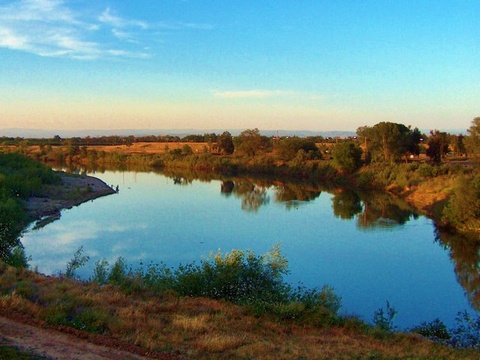The Feather River forms the boundary between Yuba County and Sutter County. It is 170 miles long, draining from a west branch and three separate forks (north, middle, and south) in the Sierra Nevada Mountain Range; all three forks plus the west branch unite in Lake Oroville in Butte County. (The middle fork also has a fork called "little north fork" that merges with it upstream from Lake Oroville.) After the Feather River flows south from Lake Oroville, the Yuba River and then the Bear River flow into it. The Feather River continues south and flows into the Sacramento River.
History
Spanish explorer Luis Arguello named the river "el Rio de las Plumas" (the River of the Feathers) because he saw many feathers floating on the water.
Hydraulic mining was done extensively on the Feather River during the Gold Rush. Due to mine tailings that were dumped into the river and raised the riverbed substantially, the river is no longer navigable north of Yuba City and is only navigable by small boats south of Yuba City. (Before that, the Feather River had been navigable to Oroville.) These mine tailings also caused the river to flood Sacramento repeatedly in the 1870s, until steps were taken to better protect Sacramento from flooding.
The Union Pacific Railroad runs parallel to the Feather River, slightly east of it. From 1949 to 1970, the California Zephyr offered passenger tours of the scenic Feather River route through the Feather River canyon (north of the Oroville). The California Zephyr trains had a feather in their logo to represent the river.
It is now the main source of water for the California State Water Project, providing water to central and southern California.
Places
Bridges
Recreation Areas
 The Feather River, seen from Yuba City. Photo by queerbychoice.
The Feather River, seen from Yuba City. Photo by queerbychoice.
- Abbott Lake
- Beckwourth Riverfront Park Complex
- Beer Can Beach
- Bobelaine Audubon Sanctuary
- Boyd's Pump
- Feather River Levee Bike Trail
- Feather River State Wildlife Area
- Lake of the Woods
- Live Oak Riverfront Park
- Mosquito Beach and Boat Ramp
- Nelson Slough
- O'Connor Lakes
- Shanghai Garden Park and Boat Ramp
- Star Bend Park and Boat Ramp
Other Places
Recreation
- Feather River Wild & Scenic Recreation Directory Websites on paddleboating, conservation, fishing, camping & hiking in and around the Feather River watershed, collected by Bruce R. Thomas
- Feather River Paddlesports Guide Rafting, canoeing, kayaking, and innertubing on the Feather River, by Bruce R. Thomas
- Feather River Fishing Report by J. D. Richey
Wildlife
Fish found in the Feather River include black crappie, bluegill, green sunfish, redear sunfish, golden shiner, and bass.1
Rare birds that can be seen at the Feather River include bald eagle, bank swallow, Swainson's hawk, and yellow-billed cuckoo. There is also a combined great egret and great blue heron rookery near O'Connor Lakes.2
Mammals living on the banks of the Feather River include American badger, North American beaver, bobcat, ring-tailed cat, coyote, black-tailed deer, gray fox, black-tailed jackrabbit, American mink, muskrat, Virginia opossum, North American river otter, raccoon, Western spotted skunk, striped skunk, and long-tailed weasel.3
Links
Feather River Wild & Scenic Recreation Directory Websites on paddleboating, conservation, fishing, camping & hiking in and around the Feather River watershed, collected by Bruce R. Thomas Feather River Paddlesports Guide Rafting, canoeing, kayaking, and innertubing on the Feather River, by Bruce R. Thomas Feather River Fishing Report by J. D. Richey Feather River entry on Wikipedia
Footnotes
1. Sutter County General Plan § 9.8 Biological Resources, 1994
2. Sutter County General Plan § 9.8 Biological Resources, 1994
3. Sutter County General Plan § 9.8 Biological Resources, 1994


